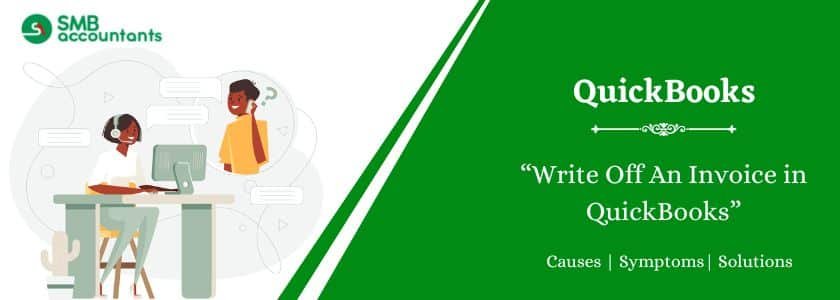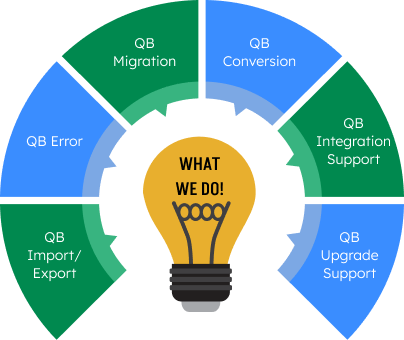Every business has to manage its money effectively, and QuickBooks has become the go-to tool for many. Writing off invoices is one part of financial management. Let’s go through the article and know the process of the QuickBooks invoice writing-off process so you can keep accurate financial records.
Table of Contents
- 1 What Do You Mean by Writing Off an Invoice?
- 2 What are the Reasons to Write off an Invoice?
- 3 How to Write Off An Invoice in QuickBooks?
- 4 Know How to Prepare to Write Off Invoices in QuickBooks
- 5 Conclusion
- 6 Frequently Asked Questions
- 6.1 Q 1: Can we write off any invoice in QuickBooks?
- 6.2 Q 2: Do I have to record it manually in my QuickBooks account?
- 6.3 Q 3: Is it possible to reverse a write-off in QuickBooks?
- 6.4 Q 4: Does writing off an invoice mean I have to open a new bad debt expense account every time?
- 6.5 Q 5: What occurs to QuickBooks’ bad debt?
- 6.6 Q 6: How does deducting an invoice from my profit and loss statement work?
What Do You Mean by Writing Off an Invoice?
It’s a simple concept. By doing this, you are acknowledging that you will not receive payment for them. For example, you may have an outstanding invoice from a business that has closed. You can enter this as a bad debt in QuickBooks. This is a kind of expense account.
You can change your accounts receivable in QuickBooks by writing off an invoice. This is the amount that is owed to your company. Also, your profit and loss report is adjusted based on your net income. This displays the earnings of your company over time. You don’t want to count money that you won’t receive as income, after all.
What are the Reasons to Write off an Invoice?
Here are some reasons why you might consider writing off an invoice in QuickBooks:
- Bad Debt: Customers may sometimes find themselves unable to pay an invoice due to circumstances beyond their control. Less commonly, customers may choose not to pay for various reasons. In both scenarios, it is crucial to accurately document a customer’s failure to make payment in your financial records by formally writing off the invoice.
- Underpayment: Your customer may have paid a portion of your invoice, leaving a remaining balance. Often, this is due to a clerical oversight on the customer’s part. In cases of underpayment, the outstanding amount is often so minimal—sometimes just a matter of cents—that it doesn’t warrant requesting the customer to settle the difference.
How to Write Off An Invoice in QuickBooks?
Choosing the Correct Invoice
Let’s select the appropriate invoice first. It isn’t as difficult as you may imagine!
- You have to go to the QuickBooks Online customer’s menu first.
- Find your customer’s account from there.
- You are going to see all of their bills.
Check the outstanding invoices now. We are more interested in them. But keep in mind that not every outstanding invoice needs to be written off. When we don’t expect an invoice will be paid, we write it off. Therefore, don’t write off a customer’s invoice just yet if you believe they may still pay.
You should choose a customer’s invoice if you are sure they will not pay. Press the button. This will cause QuickBooks to open the invoice.
Applying the write-off
We will create a credit memo to apply the write-off. In QuickBooks, this kind of transaction is unique. We can use it to lower a customer’s balance. Return to the customer’s menu and choose Create Credit Memo this time. This will bring up a fresh window.
We’ll fill in some important information here.
- Select the name of the customer from the drop-down menu first.
- Next, select bad debt as the item.
- Enter the entire amount of the outstanding invoice in the amount field.
- Click Save and Close after that.
We have now created a memo on credit.
The unpaid invoice must then be applied to this credit memo. Return to the menu for the consumer. Choose Receive Payments this time. This will cause a new screen to open. Select the name of the client from the menu. The invoice you wish to write off can then be selected in the Outstanding Transactions area. Next, choose the credit memo we just made under the Credits section.
The credit memos and the invoice amounts should match up. This means that there will be no money left on the invoice. Now click Save and Close. Now, the bill has been written off!
Read this: How to Use QuickBooks for Personal Finances
Know How to Prepare to Write Off Invoices in QuickBooks
Assessing Your Unpaid Invoices
In the starting, we are required to assess your unpaid invoices. Using QuickBooks makes this task simple. In your customer’s menu, all of your invoices are listed. You may view each customer’s account here.
Keep an eye out for past-due bills. This indicates that the customer has missed the payment deadline. There may be a few days delay on some invoices. Some invoices can be a few days late. In any case, these are the bills you haven’t paid.
Each invoice’s remaining balance is also visible to you. This is the remaining balance that the client owes. The outstanding balance will be less than the amount of the initial invoice if they have made a partial payment. It will be the same as the invoice amount if they haven’t made any payment.
Keep in mind about sales tax. In case you charge sales tax, then it is already covered in the invoice amount. The sales tax is also deducted when you write off an invoice.
Read this: How to Use Invoice Manager in QuickBooks
Setting up your Account for Write-Offs
Let’s proceed to prepare your account for write-offs. You require a bad debt expense account in QuickBooks. You keep track of your write-offs here. Such an account is an expense account.
- Begin by going to your chart of accounts.
- This is a list of every account that your company has.
- Now you have to press the New button. Next, you have to choose Expense from the list that drops down.
- Select Bad Debts as the detail type after that.
- Now you have to click Save and Close after that.
A bad debt item is also required. This is how an invoice is written off.
- Access your list of things.
- Press the “New” button.
- Next, choose “Non-Inventory” from the list that drops down.
- Select “Bad Debts” to be the account type.
- Click “Save and Close” after that.
Your account is now prepared for deductions. An invoice can be written off at any point. You have to recall that it’s a last resort. Always make an effort to get paid first. It’s time to write off the invoice if you are unable to.
Conclusion
In QuickBooks, writing off invoices is an important part of financial management for your company. It provides an accurate image of your income and helps in maintaining accurate records. Recall that you should follow this process if you are positive that an invoice will not be paid. This article’s step-by-step instructions should make the process straightforward to understand. Remember to review your outstanding bills regularly and to write off invoices using QuickBooks’ credit memo feature.
Not just the issue written above, you may face other issues as well while writing off the invoices in QuickBooks. Answers to all your queries and concerns lie with the SMB QuickBooks tech support team. Our experienced staff at the SMB QuickBooks tech support helpdesk can be reached at smbaccountants.com.
Frequently Asked Questions
Q 1: Can we write off any invoice in QuickBooks?
Ans: No, not all invoices can be written off. An invoice should only be written off if you are sure that it will not be paid. For example, you can write off an outstanding invoice from a customer who closes.
Q 2: Do I have to record it manually in my QuickBooks account?
Ans: No, you don’t have to record the writing Off invoices manually as QuickBooks automatically updates your account.
Q 3: Is it possible to reverse a write-off in QuickBooks?
Ans: Yes, you can. You have the option to reverse a write-off if a customer pays an invoice that you have written off. Applying a payment to the invoice in the same way as you would for a regular payment accomplishes this.
Q 4: Does writing off an invoice mean I have to open a new bad debt expense account every time?
Ans: No, each invoice that you write off does not need you to open a new bad debt expense account. All write-offs can be made using the same bad debt expense account. Simply put, each time you write off an invoice, it gets added to this account as another expense.
Q 5: What occurs to QuickBooks’ bad debt?
Ans: In QuickBooks, an invoice is recorded as an expense in a particular account called the bad debt expense account when it is written off as bad debt. By doing this, you can maintain accurate financial records.
Q 6: How does deducting an invoice from my profit and loss statement work?
Ans: Yes, it does. Your net income and accounts receivable are both decreased when you write down an invoice. As a result, your profit and loss report, which displays the earnings of your business over time, may be affected.



